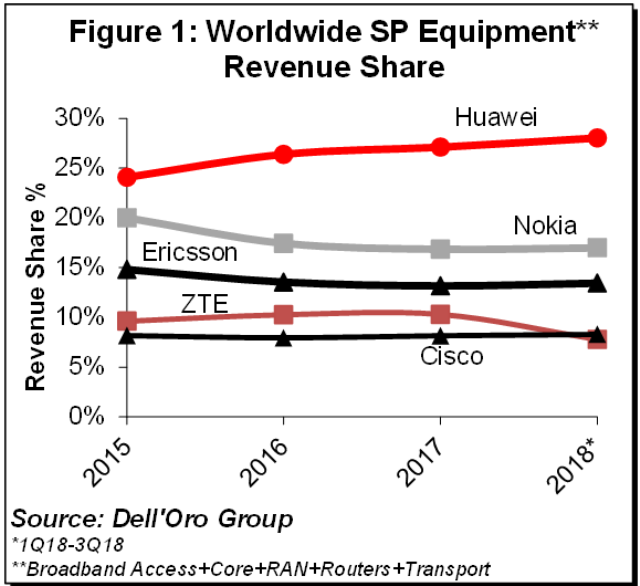American President Donald Trump is considering an executive order that would bar US companies from using telecom equipment made by China’s Huawei and ZTE, Reuters reported.
 The proposed executive order that would declare a national emergency would be the latest step by the Trump administration to cut Huawei Technologies and ZTE out of the U.S. telecom market.
The proposed executive order that would declare a national emergency would be the latest step by the Trump administration to cut Huawei Technologies and ZTE out of the U.S. telecom market.
Earlier, Japan, UK, Australia, Germany, New Zealand, among other countries, have decided to ban Huawei from supplying 5G equipment.
China-based Huawei Technologies is the #1 telecom equipment maker in the world with anticipated revenue of $100 billion. ZTE is the world’s fourth largest telecom equipment supplier.
United States alleges that the two companies work at the behest of the Chinese government and that their network equipment could be used to spy on Americans. Donald Trump earlier blocked a deal between Qualcomm and Broadcom citing the influence of Huawei behind the Broadcom offer.
The executive order, which has been under consideration for more than eight months, could be issued as early as January and would direct the Commerce Department to block U.S. companies from buying equipment from foreign telecommunications makers that pose significant national security risks.
The order is unlikely to name Huawei or ZTE. It is expected that Commerce officials would interpret it as authorization to limit the spread of equipment made by the two companies.
The executive order would invoke the International Emergency Economic Powers Act, a law that gives the president the authority to regulate commerce in response to a national emergency that threatens the United States.

The issue has new urgency as U.S. wireless carriers look for partners as they prepare to adopt next generation 5G wireless networks. AT&T, Verizon, T-Mobile and Sprint are spending on 5G equipment deals.
America’s defense policy bill passed in August barred the U.S. government itself from using Huawei and ZTE equipment.
Big U.S. wireless companies have already cut ties with Huawei. But small rural carriers have relied on Huawei and ZTE switches and other equipment because they tend to be less expensive.
Rural Wireless Association (RWA) represents carriers with fewer than 100,000 subscribers. It estimates that 25 percent of its members had Huawei or ZTE equipment in their networks, it said in a filing to the Federal Communications Commission earlier this month.
The RWA is concerned that an executive order could force its members to remove ZTE and Huawei equipment and also bar future purchases, said Caressa Bennet, RWA general counsel.
It would cost $800 million to $1 billion for all RWA members to replace their Huawei and ZTE equipment, Bennet said.
Telecom regulator FCC in April granted approval to a regulation that bars giving federal funding to help pay for telecommunication infrastructure to companies that purchase equipment from firms deemed as a threat to U.S. national security.
The FCC is also considering whether to require carriers to remove and replace equipment from firms deemed a national security risk.
In the December filing, Pine Belt Communications in Alabama estimated it would cost $7 million to $13 million to replace its Chinese-made equipment, while Sagebrush in Montana said replacement would cost $57 million and take two years.
Sagebrush has noted that Huawei products are significantly cheaper. When looking for bids in 2010 for its network, it found the cost of Ericsson equipment to be nearly four times the cost of Huawei.





